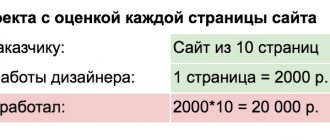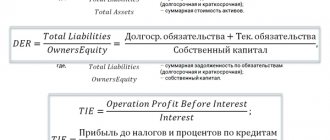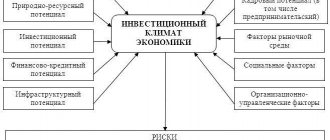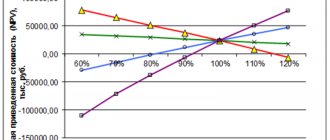Investment efficiency is the correspondence of the results obtained from the implementation of an investment project to the costs incurred.
Each investor, trying to give an objective assessment of his own investments, relies on certain indicators in his calculations. In addition, economic science has developed an independent methodology to solve this problem.
Economic assessment of the effectiveness of investments is the basis for analyzing ongoing investment processes.
Criteria for evaluating investments in terms of their profitability.
The effectiveness of investments should be assessed according to three criteria:
- Overall performance, which consists of commercial and socio-economic efficiency, and is calculated in general for the project to determine the profitability of participation in it.
- Commercial efficiency comes to the fore when the purpose of an investment is financial gain. In this case, funds can be directed to a manufacturing or trading enterprise, as well as to the service sector. In this case, the main criterion for assessing the profitability of the project will be the commercial factor.
- The social and economic efficiency of investments becomes of paramount importance if assets are invested in social facilities, the primary purpose of which is to improve the quality of life of the population. The system of criteria for assessing the effectiveness of socio-economic investments is based on identifying the main goal of a given investment project, and focusing only on progress in achieving it in accordance with approved regulatory documents.
Here we can highlight the environmental component, which consists in improving the environmental situation in the area. Despite the seeming insignificance of this aspect, it is worth considering that interest in environmental protection is steadily increasing from year to year.
- The effectiveness of business participation in the project . Both its initiator and shareholders, as well as persons indirectly participating in it - lenders, leasing companies, etc., can take part in the implementation of an investment project. Each participant has his own interests, which can either coincide with the interests of other participants or contradict them. Therefore, performance is calculated for the investor individually in accordance with his interests.
- Budgetary performance . In Russia, the largest investor is the state budget at all three levels - federal, regional and local. From a business point of view, public-private partnerships are of great interest, in which the state allows private investors to participate in commercial and socio-economic projects. In this case, both financial costs and profits are divided in predetermined proportions. By participating in a public-private partnership, a business acquires long-term investments and stable income, and also receives other benefits from the use of assets provided by the state.
Calculation of an integral assessment of the effectiveness of an investment project
To determine the return on investment, the foreign UNIDO methodology is used, as well as methodological recommendations developed by domestic specialists on its basis for assessing the effectiveness of investment projects . These methodological recommendations were created to calculate the economic efficiency of investments in a market economy; they do not apply to planned and other forms of management.
The calculation of the integral assessment of the effectiveness of an investment project must contain the following points:
- A specific goal with clearly defined quantitative indicators necessary to achieve it.
- Compliance with this goal with all regulatory documents, laws of the Russian Federation and government programs. Calculation of an integral assessment of the effectiveness of an investment project that contradicts all of the above is unacceptable.
Key indicators of investment attractiveness and efficiency
The essence of assessing the effectiveness of investments is to find the difference between material and resource investments (all investments that can be expressed in monetary terms are taken into account) and the results obtained, which, for example, to assess commercial performance are calculated by income. This can be schematically represented as a formula: “Result = final cost of the project – costs for it.” In this case, the effectiveness can be:
- Absolute. In this case, only the difference between investments and results obtained is taken into account.
- Comparative. This takes into account the likely profitability of all available project options.
The calculation of the integral assessment of the effectiveness of an investment project is influenced by many factors, most of which can only be adequately taken into account by specialists.
Fortunately for investors who are not experts in the field of analytics, the classification of indicators for the effectiveness of real investments is made according to several main factors.
Calculate according to the rules
The dynamic methodology for assessing efficiency involves taking into account the time factor against the background of assessing the value of financial investments. The discount rate must be taken into account. Typically, this indicator is taken as the average deposit percentage across banking structures. Another important parameter used in the calculations is the weighted average price of capital investments.
Thanks to the use of a discount rate, it is possible to immediately abandon projects whose internal profitability standard does not reach the depository offers of financial institutions.
Methods for assessing the economic efficiency of investment projects
Methods for assessing the effectiveness of an investment project as a whole should take into account the following factors:
- the entire period of activity of the investment project is taken into account;
- it is necessary to take into account the share of participation of each of the project participants and other interested parties, as well as the overall resultant of their interests;
- it is necessary to take into account the dynamics of changes in cash flows over the entire period of activity of the investment project;
- Only planned costs and results are subject to accounting;
- it is necessary to compare the effectiveness of all options and choose the one that promises the maximum return;
- the effectiveness of an investment project is assessed based on a pessimistic scenario;
- it is necessary to take into account the need for creating working capital, the projected amount of inflation and the impact of major risks.
Static evaluation factors
Static indicators are estimates of the effectiveness of an investment project at a specific point in time, usually the current one, or the arithmetic average of all monetary costs over the total life of the project. However, they do not take into account temporary changes, which somewhat reduces their value. Three of them are of greatest importance:
- Return on Capital Employed (P) . It refers to the level of profitability of an investment project. Widely used to calculate the following quantities:
- To calculate the comparative cost-effectiveness of different options;
- To assess the current value of a business;
- To calculate the profitability of producing a specific product or service;
Return on invested capital is calculated as the total profit received divided by the amount of investment, and is expressed as a percentage.
- Payback period of investments (PP) . It's worth noting here that not all investments pay off directly, even if the goals are successfully achieved. This usually happens in socio-economic projects. The problems of assessing effectiveness lie in the fact that the investment of any social investment, be it a school, a hospital or the construction of a highway, pays off indirectly by improving the quality of human capital or other factors of similar importance. However, it is almost impossible to accurately calculate their payback period. However, indicators of the effectiveness of investments in human capital can be calculated as a payback ratio, which shows how many invested monetary units per unit of profit.
PP= I/YNB,
where I is the total investment in the project up to the current moment, YNB is the net profit for the year.
The payback period is the period after which the investment begins to make a profit. For the rest of the time, this business pays dividends. Their size, as well as compliance with what is reflected in the business plan, in this case remains behind the scenes.
It is important to note that when assessing the overall profitability of a project, its lifespan should also be taken into account. A project with a longer life may be more profitable, even if its payback period is longer.
- Investment Performance Ratio (ARR) . Its formula is found as the average profit for the billing period divided by the total amount of investment for this period.
ARR = P(avg)/ (1/2)I(avg);
P(avg) – average profit for the year;
I(avg) – the arithmetic average of all investments to date.
This ratio is especially important in cases where borrowed funds are invested, as it allows you to calculate the expected repayment period.
We evaluate correctly
Using static indicators, you can use fairly simple calculations to evaluate the effectiveness of a particular project. The results obtained by using this technique are used as preliminary, but it is taken into account that the information is not always sufficient to assess the effectiveness of what is planned in reality. When comparing different investment projects, examining only static indicators, you need to remember that with equal values, risk parameters can differ greatly. There may also be differences in the project lifespan, which directly affects efficiency, but is not taken into account in the static calculation method.
Dynamic evaluation factors
Taking into account the time factor when analyzing and assessing the effectiveness of investments increases the complexity of calculations, but equally increases the accuracy with which it becomes possible to determine the possible benefit. Therefore, it is recommended to use dynamic factors along with static ones.
- Net present value or NVP . Calculated as the discounted amount of the expected payment stream. This indicator reflects the fact that the real value of the current amount of money will differ from the same amount at a later date in the project. This is influenced by the following factors:
- inflation;
- the profitability of a given project, which can also take a negative value.
Net present value is calculated as the sum of discounted cash flows measured over specified periods of time. In this case, the discount rate for borrowed capital must exceed the lending rate, and for equity capital it must be higher than the return on operating capital.
NPV = – I+ ∑nt=1CFt/(1+r)t,
CFt – profit from the sale of invested funds in the t-th year;
r – discount rate;
n – project lifespan in years from t=1 to n.
This indicator is very important, since it makes clear the total value of the money supply received over the entire duration of the investment project. When calculating it, it is necessary to take into account that investment can take the form of a one-time investment if it is made within one year. If the investment of funds is made over a longer period of time, then when calculating NPV it is necessary to take into account that the cost of investments will change, and it must be calculated at the discount rate.
The amount of this bet is determined individually each time based on the points that the investor chooses. The following factors may be taken into account:
If the net present value is greater than one, then the project is profitable.
- Return on Investment (PI) Ratio . It is calculated as net present value divided by the total investment.
PI = NPV/I
Both variables must be in the same currency, usually rubles or dollars. If this index is greater than one, then investments in this project will bring income. If it is less, the investment will not pay off.
- Internal rate of return (IRR) . Defined as the discount rate at which the net present value is zero. This is the maximum investment price at which the current project is not unprofitable. The internal rate of return is found either by plotting the dependence of net present value on the discount rate, or using a computer. This indicator most clearly shows the effectiveness of investment and allows you to understand whether it makes sense to invest money in a given project.
Risks and returns
The methodology for assessing these factors involves a comprehensive analysis of the activities of a legal entity. The study examines how great the investor’s risks are when collaborating with the project. An investment risk is considered to be the possible loss of a certain amount by an investor if he decides to invest in a project. Assessing hazards is a complex multi-step task in which a number of significant factors must be taken into account.
Assessing the dangers associated with investing is a stage before which you must first assess the attractiveness of the country as an investment destination, region, or industry of the enterprise. Only after receiving information that is sufficiently correct and applicable for further analysis can one work on possible dangers.
Ways to optimally improve investment efficiency
Increasing the efficiency of use of investments can increase the profitability of the project, making participation in it profitable. The following methods are used for this:
- Priority should be given to investments in the most cost-effective and technically advanced means of production. In this case, the analysis of efficiency in the case of production investments is carried out in the same way as for basic ones.
- The focus should be on investing in the production of those types of goods and services that provide the highest return on investment.
- It is worth considering that in most cases, the reconstruction of an existing production facility is cheaper than the construction of a new one.











